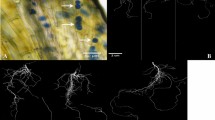Abstract
Symbiosis between fungi and plant roots forming a mycorrhiza involves extensive interactions at the molecular level between both partners. The role of plant hormones in the regulation of mycorrhizal infection is not known to involve jasmonates. Their endogenous levels increase during pathogen attack; however, little has been done on their involvement in mycorrhizae. In our recent work, root growth patterns of 2-month-old spruce seedlings after inoculation withPisolithus tinctorius and/or jasmonic acid (JA) treatment were studied using a paper-sandwich technique. Changes in root length, the degree of branching, presence and length of root hairs, and infection parameters were followed using a stereomicroscope. The first mycorrhizal contact of hyphae with roots was significantly accelerated upon treatment with 0.5 μM JA. Interactions between root hairs and fungal hyphae were seen by scanning electron microscopy. The multiplication of root hairs of non-mycorrhized seedlings treated with 5.0 μM JA and changes of the root surface were observed by the same technique.
Similar content being viewed by others
References
Aeschbacher RA, Schiefelbein JW, Benfey PN (1994) The genetic and molecular basis of root development. Annu. Rev Plant Physiol Plant Mol Biol 45: 25–45
Anderson JM (1989) Membrane-derived fatty acids as precursors to second messengers. In: Boss WF, Morre DJ (eds) Second messengers in plant growth and development. Alan R Liss, New York, pp 181–212
Atzmon N, Salomon E, Reuveni O, Riov J (1994) Lateral root formation in pine seedlings. Trees 8: 268–272
Booth C (1971) Fungal culture media. In: Methods in microbiology, vol 4. Academic Press, London, pp 49–94
Chilvers GA, Douglass PA, Lapeyrie FF (1986) A paper-sandwich technique for rapid synthesis of ectomycorrhizas. New Phytol 103: 397–402
Dathe W, Parry AD, Heald JK, Scott IM, Miersch O, Horgan R (1994) Jasmonic acid and abscisic acid in shoots, coleoptiles, and roots of wheat seedlings. J Plant Growth Regul 13: 59–62
Gogala N (1987) Jasmonic acid and methyl jasmonate —growth inhibitors for mycorrhizal fungi. In: Sylvia DM, Hung LL, Graham JM (eds) Mycorrhizae in the next decade: practical applications and research priorities. Seventh North American conference on mycorrhizae, 3–8 May 1987, Gainesville, Florida. Inst Food Agric Sci. University of Florida, Gainesville
Gogala N (1991) Regulation of mycorrhizal infection by hormonal factors produced by hosts and fungi. Experientia 47: 331–340
Gross D, Parthier B (1994) Novel natural substances acting in plant growth regulation. J Plant Growth Regul 13: 93–114
Malajczuk N, Lapeyrie F, Garbaye J (1990) Infectivity of pine and eucalypt isolates ofPisolithus tinctorius on roots ofEucalyptus urophylla in vitro. New Phytol 114: 627–631
Marx DH (1969) The influence of ectotrophic mycorrhizal fungi on the resistance of pine roots to pathogenic infections. Phytopathology 59: 153–163
Marx DH, Ruehle JL, Cordell CE (1991) Methods for studying nursery and field response of trees to specific ectomycorrhiza. In: Norris JR, Read DJ, Varma AK (eds) Methods in microbiology 23. Academic Press, London, pp 383–411
Miersch O, Günter T, Fritsche W, Sembdner G (1993) Jasmonates from different fungal species. Nat Prod Lett 2: 293–299
Ravnikar M, Vilhar B, Gogala N (1992) Stimulatory effects of Jasmonic acid on potato stem node and protoplast culture. J Plant Growth Regul 11: 29–33
Regvar M, Gogala N (1994) Can mycorrhizal fungi prolong plant life by restriction of Jasmonic acid? In: Mycorrhizas in integrated systems. From genes to plant development. Fourth European Symposium on mycorrhizas, 11–14 July 1994, Granada. Department of Soil Microbiology and Symbiotic Systems, Estacion Experimental del Zaidín.C.S.I.C., Granada, Spain
Regvar M, Gogala N (1995) The influence of Jasmonic acid on development of mycorrhizae. Acta Pharm 45: 317–319
Rupp LA, Mudge KW (1985) Ethephon and auxin induce mycorrhizalike changes in the morphology of root organ cultures of Mugo pine. Physiol Plant 64: 316–322
Staswick PE (1995) Jasmonates, salicylic acid and brassinolides. In: Davies PJ (ed) Plant hormones; physiology, biochemistry and molecular biology. Kluwer Academic, Dordrecht, pp 179–187
Thomson J, Melville LH, Peterson RL (1989) Interaction between the ectomycorrhizal fungusPisolithus tinctorius and root hairs ofPicea mariana (Pinaceae). Am J Bot 76: 632–636
Author information
Authors and Affiliations
Rights and permissions
About this article
Cite this article
Regvar, M., Gogala, N. Changes in root growth patterns of (Picea abies) spruce roots by inoculation with an ectomycorrhizal fungusPisolithus tinctorius and jasmonic acid treatment. Trees 10, 410–414 (1996). https://doi.org/10.1007/BF02185645
Received:
Accepted:
Issue Date:
DOI: https://doi.org/10.1007/BF02185645




